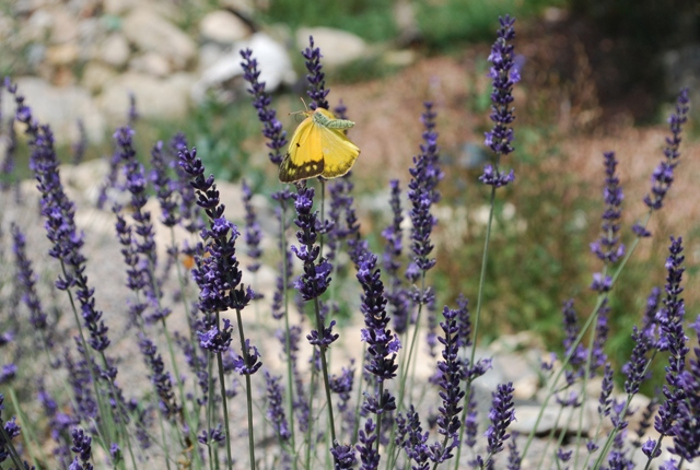As summer winds down and you plan next year’s garden, consider these five low-water perennial shrubs. There are many others, of course, but each of these has a particular feature you might be looking for when planning or revising your xeric garden. They all share in common the quality of drought tolerance. Once established in your garden, you should not need to water them at all.

Lavender is the perfect xeric plant. It also attracts bees and butterflies, and adds scent and color to the garden.
Lavender
We love this plant and it is one of our xeric plants to grow. It is also a favorite of bees and butterflies! Your biggest decision will be which cultivar to choose. Some are designed for their longer, deeper purple stems, others for culinary use or aroma. Be sure to plant your lavender in well-draining soil and give it plenty of sun. It’s hardy in zones 5 through 10, but a new lavender gets its best start in cooler zones if you wait to plant it until the ground and evenings have warmed up, several weeks after the last frost.
Yellow Bird of Paradise
All of the Caesalpinia species of plants, birds of paradise, have amazing color and interest considering their high drought tolerance. Most prefer warmer climates.
The yellow bird of paradise (C. gilliesii and recently changed to Erythrostemon gilliesii) can handle the high desert up to a point; it’s cold hardy to 15 degrees, but when kept dry, the roots can survive lower temperatures and the plant comes back the next spring. As for heat, give it all you’ve got. A favorite in Albuquerque, N.M., landscapes, the plant can reach the height of a small tree. This bird of paradise has yellow trumpet-like flowers with long red stamens. In the high desert, place it a warm microclimate, such as a south-facing wall.
Creeping Mahonia
Creeping mahonia (Mahonia repens) is an easy-care, evergreen shrub. I say evergreen, but its delicate leaves change color throughout the year. Shaped like holly leaves, but more delicate, they can be wine colored or deep, forest green. Tiny yellow flowers appear in spring.
Although creeping mahonia (sometimes called “Oregon grape holly”) can grow in sun or shade, it likes a cool spot. Ours is on the northeast side of the house, where it gets plenty of morning sun and afternoon shade. Bees love it while blooming, and it’s hardy from zones 4 through 8.

This creeping mahonia thrives on rain water only. Give it a trim for shape in early spring.
Apache Plum
The apache plume (Fallugia paradoxa) is a fun, natural-looking low-water bush. You have to love any plant that includes in its name the word “paradox,” right? The Apache plume is a paradox to me. I used to dislike its messy appearance, but I have grown to love how it looks in xeric lawns and gardens. For one, it’s semi-evergreen in warmer desert climates.
Apache plumes attract bees, produce delicate white blooms and take to strong pruning (I have even seen them shaped, though it pained me). And yet they require very little care. They’re hardy in zones 4 through 9.

The plume, or seed head, that gives Apache plume its name and adds post-bloom appeal. Our bushes are blooming again during an unseasonably warm and dry September, so we now have plumes and blooms!
Western Sand Cherry
A xeric shrub that helps you make pies. It’s like something out of a gardener’s fairy tale! But the Western sand cherry (Prunus besseyi) is the real deal.
Of course, like all fruit-bearing plants, ideal weather helps. We had some fruit on ours this year, though they were so well hidden I didn’t notice them in time. The birds enjoyed them, however, and we certainly enjoyed the showy white flowers in spring. This one is cold hardy down to zone 3. My only caution is that deer love them. We have to fence ours to keep the deer from biting off entire branches.
 |
Author Teresa Odle - Published 12-10-2020 |
